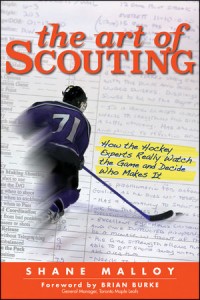
The Art of Scouting: How the Hockey Experts Really Watch the Game and Decide Who Makes It. By Shane Malloy. (2011, Mississauga, Ontario: John Wiley & Sons, Canada. Hardcover. Pp. 249. $32.95 CAN / $26.95. ISBN 978-0-470-68150.)
Shane Malloy’s foray into the fraternity of hockey scouts resulted in the well-researched book, The Art of Scouting. His narrative was, mostly, well-written and incredibly informative. Readers will come away from the book feeling as though they have gained new insight into the hows and whys of selecting players for the NHL.
The extensive quotes showed Malloy’s research in the form of interviews with current and former scouts. The majority of the book focused on how amateur players are scouted. The work that scouts and teams put into finding and developing these young men into elite NHLers goes beyond what most fans probably expect. Scouting, as Malloy showed, is as much nuance as it is mechanics.
Malloy discussed many of the variables that go into scouting both amateur and professional players. For example, he quoted a few scouts explaining how things have changed since the inception of the Collective Bargaining Agreement – “In the past, a team could sign the best player available for their system, but now the restrictive salary structure can blow up a plan instantly.”
Another perspective Malloy brought into the discussion was the wide number of amateur leagues and the difficulties of scouting within them. For those unaware of the different leagues, he took the time to explain the Junior leagues in Canada and the United States, the NCAA, high school and prep leagues, and the “big five” European leagues, plus the “Developing Hockey Nations”.
Then there are the tools used by scouts – from video scouting to computer software to statistics, no matter how modern technology contributes to scouting, nothing replaces the human beings who travel from rink to rink and country to country watching players. Interestingly, with as much focus as fans and other sports (such as baseball) place on statistics, hockey scouts do not rely on these metrics in the ways one might expect.
Part 3, “How to Tell Who’s Got Game” was the section the majority of fans will appreciate most. It delved into measuring both the tangibles and the intangibles, such as:
- Hockey Sense
- Skating
- Puck Skills Movement
- Goaltenders
- Defencemen and Forwards
In addition, at the end of nine out of the ten chapters in Part 3, Malloy included a text box he called the “Scouting Scorecard.” The scorecards included questions that scouts might ask about players in relation to the different topics.
However, there were a few things that detracted from Malloy’s narrative. In his Preface, Malloy described the book as being “for any hockey fan who ever wondered about the how and why of the secret world of scouting hockey.” By establishing this as a “secret world,” he implied that scouts are incredibly territorial and proprietary about their information. Throughout the narrative he contradicts this implication with stories of the camaraderie between scouts and how older scouts often helped the younger ones as they entered the business.
Adding to this confusion was the use of italics to attribute block quotations. Oftentimes, italics is used in a narrative to denote an alias for someone who does not want their name attributed to a quote. Every quotation used by Malloy was appropriately attributed but the italics place doubt in the mind of the reader. Finally, Malloy’s extensive use of block quotes was informative, but usually unnecessary. Using the scouts’ own words provided a personalized perspective on the scouting profession, but some of the narrative lacked an appropriate analysis in favor of giant block quotes.
Overall, The Art of Scouting should be on the recommended reading list for fans that want to understand the how and why their favorite teams acquire the players they do. It also put into perspective why some players who seem to have “it” never make it in the NHL.
Rebecca Dobrinski
For someone that’s looking to go into the scouting field someday, this is a must read. I thoroughly enjoyed reading this, and I could hardly put it down. The insight provided in this book is great. If you’re a hardcore hockey fan, you should definitely put it on your wishlist.